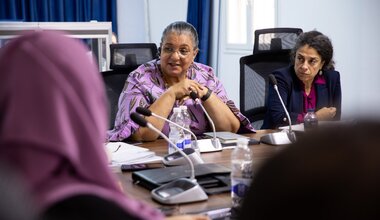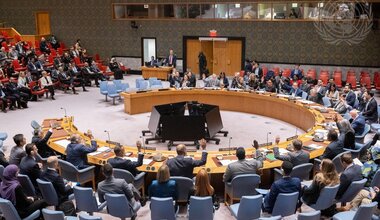Human Rights Report on Civilian Casualties - July 2018
Tunis, 1 August 2018 – From 1 July to 31 July 2018, the United Nations Support Mission in Libya (UNSMIL) documented 8 civilian casualties –three deaths and five injuries – during the conduct of hostilities across Libya. The casualty toll is the lowest on record since the beginning of the year. Victims included one man, one woman and one boy killed, and four men and one boy injured.
The majority of civilian casualties were caused by gunfire (two killed and five injured), followed by explosive remnants of war (ERW, one killed).
UNSMIL documented civilian casualties in Tripoli (two killed and five injured) and Benghazi (one killed).
UNSMIL documented 20 additional casualties from other possible violations of international humanitarian law and violations or abuses of international human rights law in Benghazi, Sabha, Tazerbu, Zliten and Zuwara.
Civilian Casualty Incidents
On 11 July, a pregnant woman was killed and her one-year-old boy injured at their Tripoli home during the exchange of fire between members of the Special Deterrence Force (SDF) armed group and the victim’s husband, who was reportedly resisting arrest. The spokesperson of the SDF was quoted in the media acknowledging that the woman had been killed by mistake.
ERWs and other unknown explosives continued to claim civilian lives in Benghazi neighbourhoods that had witnessed protracted fighting. On 14 July, a 16-year-old boy was killed when an ERW detonated in the al-Zeriri’iya neighbourhood of Benghazi.
On 15 July, a man died and another four were injured when members of the 9th Unit of the Abu Salim Central Security forces opened fire on civilians in the al-Hadba neighbouhood of Tripoli. According to information gathered by UNSMIL, local residents were attempting to protect stone-throwing children from retribution by members of the armed group whose passing car was hit by rocks.
Attribution
SDF members are believed to have caused civilian casualties in Tripoli on 11 July. The Benghazi Revolutionaries Shura Council and allies are believed to have been responsible for leaving mines and ERWs in areas of Benghazi they controlled prior to their retreat. The Abu Salim Central Security forces are believed to have been responsible for civilian casualties in Tripoli on 15 July.
Casualties from other violations of international humanitarian law and violations or abuses of human rights
On 4 July, a 10-year-old boy was killed in crossfire during a family dispute in Zliten.
On 7 July, a group of armed men opened fire at a control site near the Great Man-Made River in Tazerbu, north of Kufra, leaving an engineer and a guard dead. The motive behind the attack remains unclear.
On 10 July, the body of a local imam was brought to the Sabha Medical Centre bearing gunshot wounds. There were no armed clashes at the time of the incident.
On 12 July, a man was injured when armed men opened fire at the Commerce and Development Bank in Benghazi.
On 16 July, five adults and six children were found dead in the back of an abandoned truck in the outskirts of Zuwara. The victims together with about 100 survivors from different North and Sub-Saharan countries were reportedly travelling to an embarkation point west of Zuwara in the aim of crossing the Mediterranean for Europe. They were apparently left by their smugglers seeking to evade a checkpoint. The deceased included two Libyan children.
On 19 July, gunmen in a vehicle with tainted windows opened fire at the gates of the Literature Faculty of the Sabha University, leaving two female students injured. The identity of perpetrators and their motives remain unknown.
On 20 July, armed men shot dead a Sudanese migrant as he was leaving his workplace in Sabha.
On 26 July, unknown assailants gunned down a policeman guarding the Khadija school in central Sabha during final term examinations.
On 28 July, a man sustained a gunshot wound to the leg in the area of Salmani in Benghazi. There were no clashes in the vicinity at the time of the incident.
On 31 July, the body of a local journalist bearing gunshot wounds was brought to the Sabha Medical Centre. The identity of the perpetrators and their motives have not been determined.
Note
The figures for civilian casualties set out above only include persons killed or injured in the course of hostilities and who were not directly participating in the hostilities. The figures do not include those casualties that are not a direct result of hostilities, for example executions after capture, torture or abductions, or casualties caused as an indirect consequence of hostilities. The figures are based on information UNSMIL has gathered and cross-checked from a broad range of sources in Libya, including human rights defenders, civil society, current and former officials, employees of local governments, community leaders and members, witnesses, others directly affected and media reports. In order to assess the credibility of information obtained, where possible, UNSMIL reviewed documentary information, including medical records, forensic reports and photographic evidence.
The figures are only those that UNSMIL was able to document in the reporting period. They are not likely to be complete and may change as new information emerges about incidents involving civilian casualties that took place during this period.
Similarly, while UNSMIL has systematically tried to ensure that the cases it documented are based on credible information, further verification would be required to attain a higher standard of proof. Due to the security situation, UNSMIL has not been able to carry out direct site visits to all relevant locations in Libya to obtain information. Fear of reprisals against sources further hamper information gathering.
While not all actions leading to civilian casualties breach international humanitarian law, UNSMIL reminds all parties to the conflict that they are under an obligation to target only military objectives. Direct attacks on civilians as well as indiscriminate attacks – which do not distinguish between civilians and fighters – are prohibited. Attacks that are expected to cause incidental loss of civilian life, injury to civilians and damage to civilian objects excessive to the anticipated concrete and direct military advantage are also prohibited. Such attacks amount to war crimes that can be prosecuted by the International Criminal Court.
In order to ensure greater protection of the civilian population and essential infrastructure, all parties engaged in fighting in Libya must cease the use of mortars and other indirect weapons and imprecise aerial bombardments in civilian-populated areas, and not place fighters or other military objectives in populated areas. All executions of captives must cease and all those captured including fighters must be treated humanely in all circumstances. Murdering or torturing captives is also a war crime, regardless of what the captive may be accused of.
Cases highlighted in the “Casualties from other violations of international humanitarian law and violations or abuses of human rights” section include casualties caused during incidents that would constitute a violation of international humanitarian or human rights law, but are not a direct result of hostilities, for examples executions upon capture of civilians and others hors de combat (such as captured fighters) and torture causing death. The section also includes casualties caused by the proliferation of weapons and impunity enjoyed by armed groups and criminal networks – considered as indirect consequences of hostilities. Cases highlighted in the “casualties from other violations” section are not included in the figures for civilian casualties and include only those that UNSMIL documented during the month.
Contact UNSMIL’s Human Rights Monitoring Team to report information on civilian casualties in Libya at the following email address: unsmil-monitoringhumanrightsteam@un.org
 United Nations Peacekeeping
United Nations Peacekeeping UN
UN









